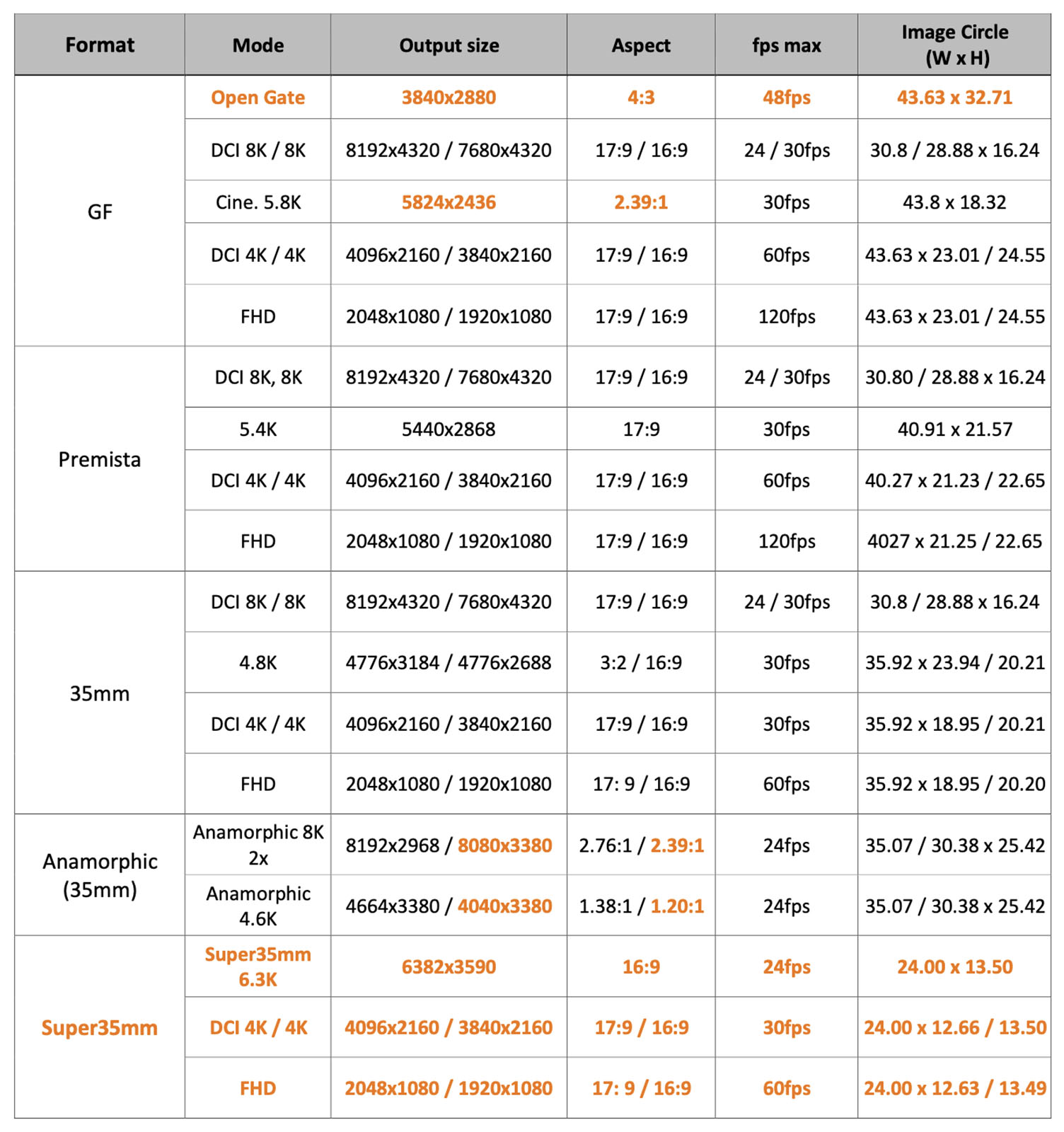Fujifilm GFX Eterna Sensor Formats, Film Simulations, and More Revealed
![]()
Fujifilm has shared new features and specifications for its upcoming medium-format cinema camera, the Fujifilm GFX Eterna.
Originally unveiled as a development announcement last year, Fujifilm has slowly dropped new details on the camera at major video shows. At CP+ in Japan in February, Fujifilm told PetaPixel that the GFX Eterna would support 4K open gate recording and feature dual base ISO. The ability to record 4K open gate is thanks to higher decoding capabilities in the GFX Eterna, making it the tallest sensor available in a dedicated filmmaking camera.
At NAB in April, the company revealed that the GFX Eterna will feature a variable electronic ND filter ranging from ND4 to ND128, use the tried-and-true NP-W235 batteries, record internally to CFexpress Type B and UHS-II SD cards, work with the TASCAM XLR Microphone Adapter Handle Accessory, and support native Frame.io integration.
Today, Fujifilm has unveiled 10 more details concerning available sensor formats, in-camera codecs, Film Simulations, and more.
Optical Low Pass Filter
To help reduce moiré and false color artifacts, the GFX Eterna will feature various filters in front of its 43.8 by 32.9-millimeter 100-megapixel image sensor. The camera has a wave plate, an IR-cut filter, and two low-pass filters. While for a stills-centric camera like the GFX 100 II, resolution is of paramount importance, for a filmmaking camera, a more natural appearance is desired, even if it is technically softer. After all, the camera is not recording 100-megapixel video — it tops out at 8K resolution instead.
GFX Eterna Sensor Formats
Speaking of the 100-megapixel sensor, Fujifilm also revealed today the different sensor formats available in the GFX Eterna. The camera can record GF format 4:3 Open Gate, as previously indicated, plus GF DCI, Premista DCI, 35mm DCI, 8K DCI (dot by dot), and Super35 DCI.
The GF format options, which correlate to using up to the full width of the sensor and GF-format optics (or ones with similar image circles), include Open Gate (3840 x 2880), DCI 8K (8192 x 4320), Cine. 5.8K (5824 x 2436), DCI 4K (4096 x 2160), and FHD (2048 x 1080). All of these use essentially the full width of the sensor, save for DCI 8K, which crops in slightly. Open gate recording tops out at 48p.
The GFX Eterna also supports Premista, 35mm, Anamorphic (35mm), and Super35 formats, ranging from FHD to DCI 8K resolution. While many of the recording options are also available on the GFX 100 II, some are unique to the GFX Eterna. In the table below, recording modes exclusive to GFX Eterna are highlighted in orange, including the impressive GF Open Gate option.

GFX Eterna In-Camera Codecs
Since the GFX Eterna is based on the GFX 100 II, it features familiar codecs, including ProRes 422, H.265, and H.264. It can record Apple ProRes 422 HQ, Apple ProRes 422, Apple ProRes 422 LT, HEVC/H.265 (4:2:2 10-bit), and ProRes and H.264 proxies directly to internal media (CFexpress Type B/UHS-II SD).
The camera can record additional codecs externally via HDMI, including 4:2:2 10-bit uncompressed and 12-bit RAW video files.
GFX Eterna 3D LUT Support
This is a short and sweet section. The GFX Eterna supports 3D LUT loading and can store up to 16 custom Lookup Table files.
Film Simulations on the GFX Eterna
The GFX Eterna supports 20 types of Fujifilm Film Simulations, including classic options such as Provia, Velvia, Astia, Classic Chrome, and Acros, among others. It also features the Reala Ace Film Simulation introduced in the GFX 100 II and the video-focused Eterna introduced back in the original Fujifilm X-H1.
![]()
Fujifilm Is Developing Film Simulation 3D LUTs
Alongside Film Simulation support in the GFX Eterna, Fujifilm announced that it is developing new 3D LUTs for select Film Simulations in F-Log2 and F-Log2 C (with ITU-R BT.709). These will be available to download from the web, and the following Film Simulations will be supported:
- Eterna
- Eterna Bleach Bypass
- Provia
- Velvia
- Astia
- Reala Ace
- Classic Chrome
- Classic Neg.
- Acros
Custom Framing Guides
GFX Eterna users will be able to customize framing guides and save them across three user-selected options. Filmmakers can select aspect ratios, such as 2.39:1 or 16:9, for example, adjust scaling, choose a color, and pick line width.
Remote Multi-Camera Control
Via a web browser-based remote control application, GFX Eterna users can control their cameras locally via a wired or wireless network.
Bluetooth Low Energy Support for Accessories
GFX Eterna features Bluetooth Low Energy (BLE) to enable connection with supported accessories, including the Atomos AirGlu and the Fujifilm TG-BT1 Tripod Grip. Furthermore, the camera will support timecode sync with select devices, including those connected over USB-C.
![]()
GFX Eterna Monitor Specs
While Fujifilm has previously shown off the GFX Eterna body itself, including its dual displays — one primary monitor and a second one for menu display — the specifications have been secret. Fujifilm unveiled today that the GFX Eterna’s primary LCD monitor is a 5-inch 16:9 panel with 6.22 million dots and an impressive max brightness of 2,000 nits, meaning it should work well in bright environments.
As for the on-board menu display, it is a smaller 3-inch panel (3:2 aspect ratio) with 1.04 million dots and a 700-nit max brightness. This is like what users find on the backs of some Fujifilm camera bodies.
When Is the GFX Eterna Coming?
Fujifilm has yet to announce a specific release date or pricing for its GFX Eterna filmmaking camera. The company has previously stated that the camera will arrive sometime this year, and all signs indicate that this remains the case. It is shaping up to be a powerful and interesting large-format cinema camera.
Image credits: Fujifilm